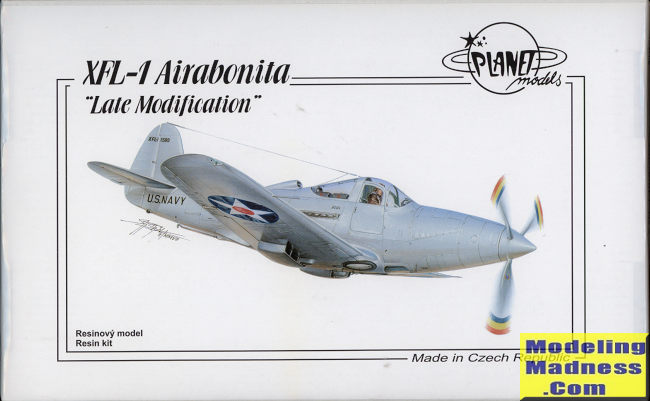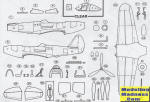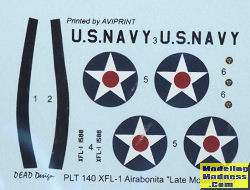
| KIT #: | 140 |
| PRICE: | . |
| DECALS: | One option |
| REVIEWER: | Frank Scott Van AkenReynolds |
| NOTES: |
|

| HISTORY |
In January 1938, the U.S. Navy issued a specification for a light carrier-based fighter to replace the obsolete biplanes then in use. On 11 April 1938, Bell, Brewster, Curtiss, Grumman, and Vought-Sikorksy submitted proposals but only three received contracts. Two of them were awarded contracts for one prototype each on 30 June 1938; these were for the Grumman XF5F-1 Skyrocket and the Vought-Sikorsky XF4U-1 Corsair. The third contract, which was signed on 8 November, went to Bell Aircraft for one XFL-1 Airabonita. All three aircraft made their first flight in 1940: the XF5F-1 on 1 April, the XFL-1 on 13 May, and the XF4U-1 on 29 May.
Subsequent tests were prolonged because of difficulties with the Allison engine and problems with the balance of the aircraft. Official evaluation began in July 1940 but the XFL-1 failed to be certified for carrier operations because of main landing gear problems. The prototype was returned to Bell for modifications in December 1940 and returned to the Navy on 27 February 1941 at Naval Air Station Anacostia, District of Columbia. Based on the test results, the Navy decided not to order production of the aircraft.
In February 1942, the XFL-1 was transferred to the Aircraft Armament Unit at U.S. Naval Air Station Patuxent River, Maryland. It was later grounded, used for armament tests, and later destroyed. For many years its remains were visible at the dump at NAS Patuxent River.
As a possible further reason for the rejection, it is often stated that the Navy's position during that era was that all its aircraft should use air-cooled engines (while the Allison was liquid-cooled). This appears an unfounded speculation. The U.S. Navy "would consider a liquid-cooled engine installation provided a material increase in performance over air-cooled engine can be shown."
In addition, the Allison engine had only a single-speed supercharger. Consequently, its altitude performance was much inferior to other naval fighters of the period, such as the Grumman F4F Wildcat.
Lastly, the Airabonita had to compete against the considerably faster though not "light" Vought F4U Corsair, the first U.S. Navy fighter to exceed 400 mph (644 km/h) in level flight.
| THE KIT |
 Planet
Models is the 'kit' branch of CMK resin, itself part of the Special Hobby/MPM
family of products. As expected from CMK, the resin is superb with the usual
very thin flash on some pieces. The kit is fairly simple as resin kits go and
would be a perfect initial introduction into resin for those ready for the
experience.
Planet
Models is the 'kit' branch of CMK resin, itself part of the Special Hobby/MPM
family of products. As expected from CMK, the resin is superb with the usual
very thin flash on some pieces. The kit is fairly simple as resin kits go and
would be a perfect initial introduction into resin for those ready for the
experience.
The cockpit is pretty standard stuff with seat, stick, floor, rear bulkhead and radio shelf. No rudder pedals are provided, which I thought was an interesting omission, but perhaps they cannot be seen. Before assembling the fuselage halves, the exhaust, instrument panel, tail gear assembly, forward blanking plate and if you want the prop to spin, the propeller assembly need to be installed along with the cockpit. The kit provides both a complete prop blade piece and separate blades. While the latter would make it easy to deal with the spinner/backing plate seam, one then has to deal with alignment of the blades.
Both the wings and the tailplanes are a single casting, which helps ease assembly quite a bit. The plane was unarmed so one only has to install pitot tubes into the wings. Two vacuform canopies are provided and after attaching the roll over hoop, one can then attach the canopy. On the bottom of the aircraft is a square window ant one needs to cut this from a sheet of clear acetate. The rear engine intake fits atop the fuselage behind the canopy.
The rest of the build is under the wing center section with the landing gear and the radiators being placed there. What makes this the 'late modification' kit are these larger radiators, which were installed to improve engine cooling.
 Instructions are well done with nicely drawn illustrations and general color
information provided. This plane was in overall aluminum, and may well have been
aluminum paint instead of bare metal as naval aircraft were rarely unpainted due
to the need to protect from salt corrosion. The decal sheet is quite basic
providing insignia, wing walk areas, and prop decals. This plane did not have
the upper yellow wings and rudder stripes of the initial rollout of the plane.
For those interested, other differences with the initial roll out plane are that
the 'early' version had a collector exhaust and a smaller scoop on the upper
fuselage. I'm sure Planet has a boxing of this variant.
Instructions are well done with nicely drawn illustrations and general color
information provided. This plane was in overall aluminum, and may well have been
aluminum paint instead of bare metal as naval aircraft were rarely unpainted due
to the need to protect from salt corrosion. The decal sheet is quite basic
providing insignia, wing walk areas, and prop decals. This plane did not have
the upper yellow wings and rudder stripes of the initial rollout of the plane.
For those interested, other differences with the initial roll out plane are that
the 'early' version had a collector exhaust and a smaller scoop on the upper
fuselage. I'm sure Planet has a boxing of this variant.
| CONCLUSION |
| REFERENCES |
https://en.wikipedia.org/wiki/Bell_XFL_Airabonita
November 2018
Copyright ModelingMadness.com. All rights reserved.
If you would like your product reviewed fairly and fairly quickly, please contact the editor or see other details in the Note to Contributors.
Back to the Main Page Back to the Review Index Page Back to the Previews Index Page